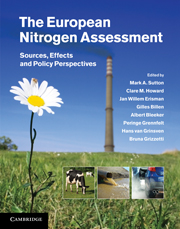Book contents
- Frontmatter
- Contents
- List of contributors
- Foreword
- Summary for policy makers
- Technical summary
- 1 Assessing our nitrogen inheritance
- Part I Nitrogen in Europe: the present position
- Part II Nitrogen processing in the biosphere
- Part III Nitrogen flows and fate at multiple spatial scales
- 10 Nitrogen flows in farming systems across Europe
- 11 Nitrogen flows and fate in rural landscapes
- 12 Nitrogen flows and fate in urban landscapes
- 13 Nitrogen flows from European regional watersheds to coastal marine waters
- 14 Atmospheric transport and deposition of reactive nitrogen in Europe
- 15 Geographical variation in terrestrial nitrogen budgets across Europe
- 16 Integrating nitrogen fluxes at the European scale
- Part IV Managing nitrogen in relation to key societal threats
- Part V European nitrogen policies and future challenges
- Glossary
- Index
- References
11 - Nitrogen flows and fate in rural landscapes
from Part III - Nitrogen flows and fate at multiple spatial scales
Published online by Cambridge University Press: 16 May 2011
- Frontmatter
- Contents
- List of contributors
- Foreword
- Summary for policy makers
- Technical summary
- 1 Assessing our nitrogen inheritance
- Part I Nitrogen in Europe: the present position
- Part II Nitrogen processing in the biosphere
- Part III Nitrogen flows and fate at multiple spatial scales
- 10 Nitrogen flows in farming systems across Europe
- 11 Nitrogen flows and fate in rural landscapes
- 12 Nitrogen flows and fate in urban landscapes
- 13 Nitrogen flows from European regional watersheds to coastal marine waters
- 14 Atmospheric transport and deposition of reactive nitrogen in Europe
- 15 Geographical variation in terrestrial nitrogen budgets across Europe
- 16 Integrating nitrogen fluxes at the European scale
- Part IV Managing nitrogen in relation to key societal threats
- Part V European nitrogen policies and future challenges
- Glossary
- Index
- References
Summary
Executive summary
Nature of the problem
The transfer of nitrogen by either farm management activities or natural processes (through the atmosphere and the hydrological network) can feed into the N cascade and lead to indirect and unexpected reactive nitrogen emissions.
This transfer can lead to large N deposition rates and impacts to sensitive ecosystems. It can also promote further N2O emission in areas where conditions are more favourable for denitrification.
In rural landscapes, the relevant scale is the scale where N is managed by farm activities and where environmental measures are applied.
Approaches
Mitigating nitrogen at landscape scale requires consideration of the interactions between natural and anthropogenic (i.e. farm management) processes.
Owing to the complex nature and spatial extent of rural landscapes, experimental assessments of reactive N flows at this scale are difficult and often incomplete. It should include measurement of N flows in the different compartments of the environment and comprehensive datasets on the environment (soils, hydrology, land use, etc.) and on farm management.
Modelling is the preferred tool to investigate the complex relationships between anthropogenic and natural processes at landscape scale although verification by measurements is required. Up to now, no model includes all the components of landscape scale N flows: farm functioning, short range atmospheric transfer, hydrology and ecosystem modelling.
- Type
- Chapter
- Information
- The European Nitrogen AssessmentSources, Effects and Policy Perspectives, pp. 229 - 248Publisher: Cambridge University PressPrint publication year: 2011
References
- 7
- Cited by

